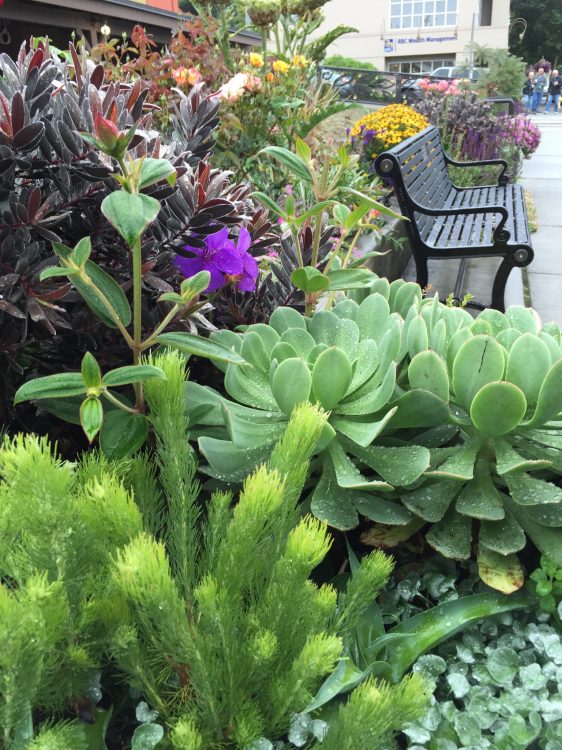 The Ebony Bed
The Ebony Bed
Retaining its name from 2015, Ebony comes from the beautiful, black Leucadendron ‘Ebony’ featured in the “boxes.” These Leucadendron were perhaps our most prized plants from last year; new introductions that we stumbled upon on our January trip to Monterey Bay Nursery. Monterey Bay was reluctant to release them, having only a small number of plants in stock that they wanted to grow to size. We were able to persuade them to release two to us over the course of last spring—here they are still for you to admire!
We had no idea that these ‘Ebony’ beauties would be content in these mixed plantings, let alone survive the winter (which they did with minimal tip damage!). Like other members of the Proteaceae family, Leucadendron are sensitive to phosphorus; however, these plants seem to not be affected by the time-release Osmocote applied seasonally to the beds. We are eager to see if they will bloom in Edmonds. This year we noted Monterey Bay’s motherstock flowering with deep blood-red bracts.
A handful of other 2015 plants have come back beautifully here as well: Salvia nemerosa ‘Blue Marvel’ (if you are looking for an awesome, longer-blooming & larger-flowered nemerosa, THIS IS IT!), Stachys ‘Primrose Heron,’ Heuchera ‘Binoche,’ and Convolvulus mauritanicus ‘Morrocan Beauty.’ Surprisingly, some of the Coleonema ‘Sunset Gold’ has also overwintered (along the sidewalk). However, the most commented on plant that has returned from 2015 is the giant Artichoke (Cynara scolymus) ‘Emerald’ in the center of the main bed. Despite pleas from hungry admirers, we’ve chosen to let it flower to demonstrate its beauty as an ornamental (and to compete with the Cardoons that Deb & co. have planted a few blocks south!).
New and noteworthy here this year are the Adenanthos sericeus (aka Coastal Woollybush) and Tibouchina urvilleana (aka Princess Flower) accompanying the Leucadendron in the boxes. Another of the “touch me” plants in the plaza, the Adenanthos is an Australia native and its species name sericeus means “silky.” Like the Leucadedron, it’s also a member of Proteceae family and usually grows into a large shrub or small tree. We love the soft velvety feel of this plant, along with its lax habit and blushed new tip growth. If we’re lucky enough to see these Adenanthos bloom, we’ll be treated to bright scarlet tubes, that should also be a hit with the hummingbirds of Edmonds.
Two succulent trials here are Yucca desmetiana ‘Blue Boy’ and Senecio vitalis ‘Blue Pencil,’ both planted mixed with perennials, roses, shrubs, and annuals. While showcasing their beautiful colors, our intent is also to demonstrate the versatility of these different kinds of succulents in a mixed border. We took inspiration from Annie’s Annuals’ use of the soft-bladed Yucca ‘Blue Boy’ by planting a grove of these dusky grape specimens, which are typically slow-growing. These plants should have little problem coming through a winter or two in Edmonds, as they are hardy to about 15 degrees.
You’ll see Senecio ‘Blue Pencil’ also in mass on the other side of the main bed. Though there are many blue ‘chalk fingers’ types of Senecio, ‘Blue Pencil’ has really endeared itself to us over the years. It tends to grow taller faster, stay more upright, and is wispier than the ubiquitous Senecio mandraliscae. We also love ‘Blue Pencil’s’ slightly more sea-green color, and have noted that it coexists well with other types of garden plants in mixed containers, despite being a succulent.
back to the Petula Test Garden page